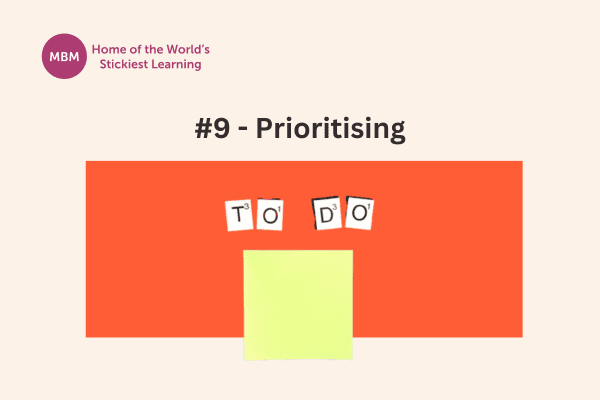Account planning is about taking the ‘helicopter view’, as my old boss used to say. Taking a step back to see what more is possible from your efforts.
Thinking about account planning, let’s talk about two lumberjacks cutting down trees. The two brothers started work early to hit their quota. Each allocated a patch of forest to deforest, by their supervisor.
Competitive and equally hard-working, they got their orders from the boss and began making their way to their assigned patch. All day they each slogged to achieve their tough quota and as the sun dipped, they both walked back wearily to the boss’ office and told the boss how well they had done.
The first lumberjack had hit his quota and received his bonus. The second discovered whilst pointing on the map what he had done, that he had cut down trees but on the wrong patch – having not listened at the start of the day because he was ‘keen to get on.’
The moral?
Often, as account managers, we work hard every day, but could we be working smarter? Getting more from less. Using our precious resources – ourselves – better?
Always. Sometimes stepping back enables us to move 3 steps forward. Let’s do some simple and effective account planning…
Account Planning Mistakes

For the purposes of this article, I am assuming that you are an account manager/sales manager/rep and you have a bunch of customers. Plus, you are a little frustrated just achieving your sales target like a baseball player just sliding onto the base, and would rather hit a home run of a sales performance.
The mistake most account managers make is that they spend too much time IN the business and not enough time ON the business. This hints back to our lumberjack metaphor above. Or the other mistake they make is finally carving enough time to do some planning, and in which they create fabulous plans but they don’t live & breathe and simply sit on a shelf gathering dust doing nought.
Let’s not make either of those mistakes by creating a simple and effective plan which lives and breathes, and help us to achieve more, rather than the tail-wagging dog of a plan that we merely update for updating sake, and it never helps us to make better decisions. Please keep these in mind as we work through the 10 steps of account planning.
Step #1: Begin with the End in Mind

Stephen Covey, the author of The 7 Habits of highly effective people wrote in Habit #2 – ‘Begin with the End in Mind.’ He said that everything was created twice – first in mind and second in reality.
Sidenote: I have seen thousands of range reviews by suppliers and buyers happen. They are a gruelling process of changing products in a supermarket store, and 90% begin without identifying what they want to achieve. Let’s learn from their mistakes…
For this process, what do you want to achieve? This a tough question but let’s start somewhere because otherwise, our objective is to do the account planning process. It is not.
Our objective is to sell more – how much? For now, take a guess because I believe that you have worked every day on these accounts, and possibly for years, so your gut instinct is right when it just said 20%, £250,000, or whatever it said. Let’s roll with it. Write down that number nice and big somewhere and we’ll come back to it later, allowing our subconscious to do its work.
Step achieved? That’s the easy step once you have identified your number.
Move on to step 2…
Step #2: Who are Your Five-Star Customers?

Richard White, the founder of the Naked Salesman, shared with me his view on customers as 5-star customers. I must admit that it took me a little while to grasp the concept but when I did, it was a game changer.
Richard said that salespeople are too busy chasing everyone when they should be chasing those with the problem that they have the solution for. For example, if your healthy snacking product has more protein than your competitors, find people that go to the gym. Your cruise line caters for the non-cruiser, find where non-cruisers shop for holidays. Fed up with people going on training courses and doing nothing differently? Try the world’s stickiest learning (Shameful plug!).

Not everyone is a potential customer. I know for MBM that many companies just want to tick the box of training and changing behaviours is not something they want to achieve. We need to act like doctors finding people that have the pain/the problem that we have the cure for.
Sidenote: Richard taught me that having understood the above when writing a newsletter, or email prospecting use this formula:
The problem they have but they do not want. The solution they want but do not have.”
For example:
Struggling with people going on training courses and then doing nothing different?
Enable your learners to change their behaviours with our unique training method – sticky learning.
The first line should always be emotional.
Back to 5-Star Customers – Who Are They?
Who is your ideal customer? It’s not as easy to answer as you might first think. Identify 5 attributes that make a 5-star customer for you. For example, our ideal customer is:
- The HR Manager/L&D Manager is frustrated with people going on training courses and then doing nothing differently.
- The HR Manager/L&D Manager wants to be able to prove an ROI.
- UK based.
- A budget of x for training.
- A supplier to a UK supermarket.
Please write the 5 attributes of your 5-star customer. It’s a good idea to look at which customers perform well with your business as this may give you clues as to the attributes you want in a 5-star customer.
The attributes you might look for are; able to give repeat business, being easy to work with, sharing similar values, paying their bills on time, etc. It will be different for each business and it is no easy feat to identify who they are.
Who are Your 5-Star Customers?
The next part of step 2 is to list all your customers in column 1 and then add columns for each of the 5 attributes. Now work through your customer list putting a tick against each customer for each attribute. Then, total the ticks against each customer.
You now know who your perfect customers are and the not-so-perfect ones. This does not mean that we stop working with less than 5-star customers. It does mean that we are starting to learn why they work with us and why we work with them, and maybe why the less than 5-star customers are a bit trickier or perform less well with you.
What surprises did you find?
Step achieved? Once you have identified the 5 attributes of a great customer for your business and measured your customer list using this measuring device we have achieved step 2 of account planning.
Move on to step 3…
Step #3: Boston Matrix Your Customers

If you are unfamiliar with a Boston matrix it is a window of 4 boxes invented by the Boston Consulting Group – hence the name. This matrix simply enables you to plot items according to two axes. For this account planning exercise, we are going to use the axis of:
- X-axis (Also known as the cross-axis) is going to be size, which is the size of the current customer with you, in sales value.
- Y-axis is going to be the potential. This is your best guess at this stage of their potential with you. Have you maximised their spending on what you sell, or is there more to be had? If you don’t know, ask. But don’t let it hold up your account planning. Get the answers and feed them in as you have them. Remember, this is a living and breathing plan.
Go Old School
My suggestion is to go old school. The temptation is to use Excel. The challenge with Excel is that we spend too long making it look pretty and we want a simple and effective plan.
So, an A3 page (Two A4 pages stuck together) and Post-it notes. You have a third dimension on your Boston matrix – stars. Each Post-it note is a customer’s name with their amount of stars and that Post-it note is placed on the 4 boxes according to their current size and their potential.
Move the Post-it notes around because they need to make sense in reference to each other. For example, W is bigger than the X customer, so they need nudging to the right. Or, hold on, Y has much more potential than Z, so that Post-it note gets moved up a bit.
Coupled with the stars, once each Post-it note is placed you have a very comprehensive map of your customer’s size, potential and fit. All on one A3 page.
Once you have done this once, excel is an option, but only once you have gone old school first.
Step achieved? You should now have an A3 sheet full of Post-it notes on a Boston matrix, with some scribbles probably drawn on it, as you have seen stuff and want to remember those insights.
Move on to step 4…
Step #4: Step Back

This helicopter view is essential. It is probably the first time that you had had all this intelligence on one page. A complete map of your customers on 3 dimensions; fit, size, and potential. You are now the lumberjack who can make decisions about which trees to chop because you’ll know where to place your efforts for maximum return.
These are the sorts of questions I’d like you to ask yourself. Remember that you are <your name>, and you only have a finite amount of resources (your time) and these questions are challenging you as to where you might put that resource in order to achieve your step 1 – end in mind.
- What insights can you take away?
- What’s common about the customers in each box?
- Who is a surprise?
- What makes sense/doesn’t make sense?
- When you look at the potential how do you feel – worried or excited?
- What information do you not have that you want to get to update this account plan?
- Who in your business would you like to show this to to get their perspective?
Don’t rush this time. You have uncovered a great map to the future. If you don’t have time now come back to it when you do.
Step achieved? You should now have some wonderful reflections and lots of things that surprised you and that you did not know. At this point, the exercise of account planning has already been worthwhile. Don’t stop now, keep going.
Move on to step 5…
Step #5: Identifying Strategies for Each Box

The power of a Boston matrix is in its ability to help us prioritise. In BCG’s classic matrix, see below, they named each box.
The first priority was the top right box because it had the biggest market share and the biggest potential. Whilst the bottom left box had the opposite. The other two boxes are really a personal choice as to which one is number 2, or 3, if the top right is 1, and the bottom left is 4, in terms of priority.

Identify a broad way forward that you want to take, for each box. For example, the top right box (1) might be to visit them weekly, give them the grand tour, or update yourself weekly on the account progress. For the bottom left box (4) it might just be to do whatever you can do to keep the business with minimum effort. Other strategies for each box might be:
- Push Very Hard
- Defend Like Hell
- Red Carpet Roll-Out
- Get Rid Asap
And so on. By identifying a broad way forward for each box, you are then, choosing how much effort to put into that box, and in turn those customers. Add a title to each box with 3 words. The brain likes 3 words. Plus, be creative and have a little fun with it because at some point you’ll probably want to share your plan of attack with your account team/boss, and no one wants yet another dreary plan to listen to.
Sidenote: On the Road Reps
For ‘on-the-road reps’ your approach could be about the frequency of visits. In essence, allocating how many times you visit each customer according to the box they are in.
Google Maps has a push-pin feature where you can plot all your customers on a map. This will help you to visually see your customers and also to create more effective on-the-road days by visiting customers in a similar area.
Step achieved? Each box has a strategy and one that you can start to see will drill down by the customer.
Move on to step 6…
Step #6: Learning from Each Customer

Each box now has a strategy, from step 5. Step 6 is about taking each box in turn and applying that box strategy to each customer. We’ll work in this order of boxes:
- The top right is box 1.
- The top left is box 2 because I always believe that if a customer has the potential to expand with us, then we can make that happen.
- The bottom right is box 3.
- The bottom left is box 4.
Write those numbers on your A3 page.
Let’s begin with box 1 (top right). In that box, you have a list of customers showing their current size, their potential and their fit (stars). Make a list on an A4 page of those customers in column 1. Add the box strategy as the title of this A4 page. In column 2 title this ‘Size’, column 3 is ‘Stars’, and column 4 is titled ‘Potential’.
The next part is to take each customer in turn, considering their current size, fit, and potential. Under each column add some notes. The objective of this part of the account planning process is to learn why we have achieved/have not achieved what we have with that customer. For example:
In Column 2 – Size – Next to Customer X – Add Notes, Answering Questions like:
- What was instrumental in making that customer one of the largest?
- How likely are we to lose them?
- Why do they buy from us?
Richard White, the Naked Salaman author, talked about whether the internal reality met the external perception. Often companies sell their products or service on the benefits they offer, and yet customer buys for another reason.
Real magic happens when the internal reality matched the external perception. For example, we sell behavioural change, through sticky learning, and the customer buys this solution because they are frustrated by learners coming back from training courses and doing nothing differently.
For many companies what they sell, people don’t buy. Apple realised that people bought their Macs because people wanted to be part of a certain lifestyle. So their selling was more about a lifestyle, as well as great functionality. Stella Artois realised that people bought their brand because it was a little exclusive, as dictated by the price. So SA capitalised on this with their advert ‘Reassuringly expensive.’
People don’t buy drills, they buy holes.”
In Column 3 – Fit – Next to Customer X – Add Notes, Answering Questions like:
- Why do they have that many stars?
- Or so few stars, yet they are in the top right box?
- What stars can you add for them by doing something?
In Column 4 – Potential – Next to Customer X – Add Notes, Answering Questions like:
- Why do they have that potential?
- Why have we not grabbed that potential to date?
- Are we able to grab that potential?
(P.S. You will need to add column 5, so leave some room.)
Step achieved? Each customer now has notes against their name under each of the 3 columns of current size, fit, and potential.
Move on to step 7…
Step #7: Where the Rubber Hits the Road!

In step 6 we gained valuable insights into our customers; how they perform and why they perform the way they do. Now, it’s time to figure out what we do with all those learnings and decide on a way forward. This step is not for the faint-hearted because it is about making choices and choosing is hard. Deciding whether to go left or right.
Often, we’ll try to take the middle route because it means we have got the best of both worlds. Often we haven’t, and we’ve just fudged the decision and not made really any decision at all. For example, in choosing to delete a customer or visit one less, many might choose, well, we can do all this new stuff and all the old stuff too. You can’t. Your resources are limited and you need to prioritise where you get the best return for the resource employed.
For Example, Small Customers Can Take Up a Huge Amount of Time
Let’s say we are a printer and our 5-star customer is one that 1. Places big orders, 2. Makes our printing presses run all day long with no need for change-overs, 3. Paying their bills on time, 4. With little support needed, and 5. They repeat every year. A 5-star customer.
In contrast, a start-up company is the opposite, wanting hand-holding through the packaging process, lots of mock-ups needed, taking up all of the studio’s time, wanting reassurance all the time that their products are brilliant, and maybe they won’t be here in a year. A zero-star customer. Though, their potential is huge, maybe.
We need to take decisions and stick by them. Some decisions will be wrong, but at least we decided, and as long as you get more right than you get wrong, you should end up out on top.
Customer Lists on A4 Pages – Adding Column 5
Back to our four A4 pages of customer lists. One for each box. Working in the same order of boxes, 1 to 4, go through the customer lists, being mindful of the 3-word strategy you gave to each box which is at the top of this A4 page.
Box 1 might be titled ‘Attach, Attack, Attack.’ Next to each customer, add an action/s under column 5 – ‘Action.’ This is where you decide what you are going to do about each customer to achieve the overall box strategy. Be mindful that your resources are limited, so for anything new you add here, you need to remove the equivalent resources from the other boxes.
You might add action and I’d recommend up to 3 actions only because this is a simple and effective account plan that will live and breathe, and so you’ll want to review your decisions and progress monthly. For example, visit the customer monthly (Currently quarterly), give them a grand tour of our facility, and organise an exploratory meeting to ask lots of questions about what is possible together.
As you come to boxes 2, 3, and definitely 4, you are aiming to do less because you have no doubt increased your resources for the customer in box 1. Remember, you cannot do it all and this account planning process was about getting more from less, or certainly getting more, even if you kept the same resources. It was most definitely not about doing more.
Step achieved? Each customer now has up to 3 actions by their name.
Move on to step 8…
Step #8: Sense Check Your Plan Against Your Target

Sense check what you have achieved by grabbing that target you wrote in step 1. Taking the A3 sheet, add a sales value number on all customers in box 1, and those customers that have 4 or 5 stars. These are the best-fit customers that are already important to you, in their size, and have great potential. Add up the numbers from each customer Post-it note of the box 1 customers with 4/5 stars.
Does the target you wrote get met by the potential? It should do. If it doesn’t, what can you change, or are you happy that the potential is enough? Or do you need to go back and tweak something?
Step achieved? Your potential sales value equals or is higher than your target.
Move on to step 9…
Step #9: Prioritising the Priorities

From step 7 you have potentially 3 actions per customer and if you have 10 customers, that is 30 actions. Let’s take the priorities and prioritise them.
To do this, imagine that your pen only has 7 ticks in it. Reading through the 30 actions add a tick next to the action that will make the biggest difference and is the easiest to get done. You can put all your 7 ticks against one action or distribute 7 ticks across 7 actions, or anything in between. But you only have 7 ticks. Get ticking…
Step achieved? You now have your absolute priorities to get started – anywhere between 1 action and 7 actions. This is the tip of the sword.
Move on to step 10…
Step #10: Making Your Account Plan Live and Breathe

I have seen many a great plan that has sat on a dusty shelf. What a shame! All that work to achieve zip. Another decision we need to make coming up…
How often do you review the plan? And how do you review it?
For example, monthly you review the top tick actions, and box 1 progress, and annually do the whole process from top to bottom.
My top tip is that it has to work for you. Don’t commit to what you cannot achieve because you will become disconcerted and never go back to the plan. Small confident steps at the start are the key, and making progress so that your brain releases the endorphin rush of a job well done.
Step achieved? You have written down how often and how you will review your account plan.
Account Planning as a Team
The 10 steps above can be done as an individual or as a team. My recommendation is to approach the task as a team and account plan together and use an external facilitator. Why?
- Using an internal facilitator means that the person has to both manage the process and contribute. They cannot do both well.
- An external facilitator has a process and a model to use. Like the 10 steps above to account planning, just with even more detail.
- Experience: An external facilitator has done over +100 account plans and knows the pitfalls that the group will fall into.
If you want to do your account planning as a team and need an external facilitator, please contact us.
Summarising Account Planning in 10 Steps
- Step #1: Begin with the End in Mind.
- Step #2: Who are Your Five-Star Customers?
- Step #3: Boston Matrix Your Customers.
- Step #4: Step Back.
- Step #5: Identifying Strategies for Each Box.
- Step #6: Learning from Each Customer.
- Step #7: Where the Rubber Hits the Road!
- Step #8: Sense Check Your Plan Against Your Target.
- Step #9: Prioritising the Priorities.
- Step #10: Making Your Account Plan Live and Breathe.
Enjoyed this article? Show us some support on our YouTube channel by liking and subscribing. We appreciate it.



